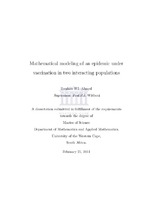| dc.description.abstract | In this dissertation we present the quantitative response of an epidemic of the so-called SIR-type, in a population consisting of a local component and a migrant component. Each component can be divided into three classes, the susceptible individuals, usually denoted by S, who are uninfected but may contract the disease, infected individuals (I) who are infected and can spread the disease to the susceptible individuals and the class (R) of recovered individuals. If a susceptible individual becomes infected, it moves into the infected class. An infected individual, at recovery, moves to the class R. Firstly we develop a model describing two interacting populations with vaccination. Assuming the vaccination rate in both groups or components are constant, we calculate a threshold parameter and we call it a vaccination reproductive number. This invariant determines whether the disease will die out or becomes endemic on the (in particular, local) population. Then we present the stability analysis of equilibrium points and the effect of vaccination. Our primary finding is that the behaviour of the disease free equilibrium depend on the vaccination rates of the combined population. We show that the disease free equilibrium is locally asymptotically stable if the vaccination reproductive number is less than one. Also our stability analysis show that the global stability of the disease free equilibrium depends on the basic reproduction number, not the vaccination reproductive number. If the vaccination reproductive number is greater than one, then the disease free equilibrium is unstable and there exists three endemic equilibrium points in our model. Two of these three endemic equilibria are so-called boundary equilibrium points, which means that the infection is only in one group of the population. The third one which we focus on is the general endemic point for the whole system. We derive a threshold condition that determines whether the endemic equilibria is locally asymptotically stable or not. Secondly, by assuming that the rate of vaccination in the migrant population is constant, we apply optimal control theory to find an optimal vaccination strategy in the local population. Our numerical simulation shows the effectiveness of the control strategy. This model is suitable for modeling the real life situation to control many communicable diseases. Models similar to the model used in the main contribution of our dissertation do exist in the literature. In fact, our model can be regarded as being in-between those of [Jia et al., Theoretical Population Biology 73 (2008) 437-448] and [Piccolo and Billings, Mathematical and Computer Modeling 42 (2005) 291-299]. Nevertheless our stability analysis is original, and furthermore we perform an optimal control study whereas the two cited papers do not. The essence of chapter 5 and 6 of this dissertation is being prepared for publication. | en_US |

